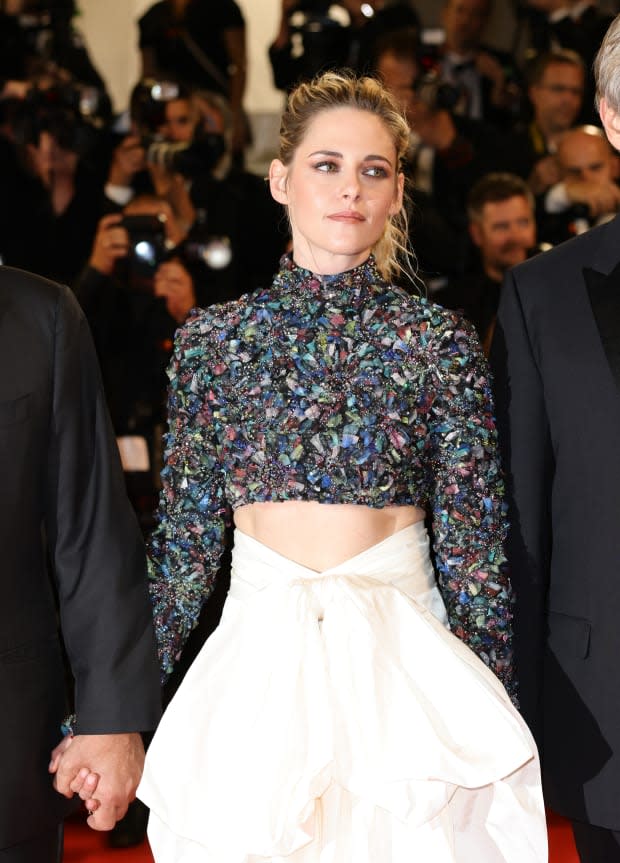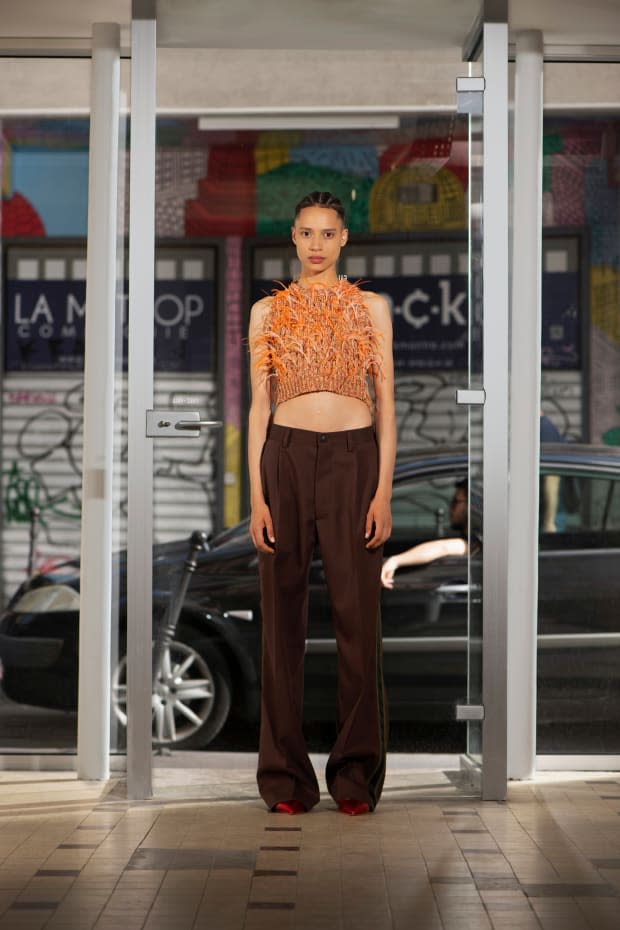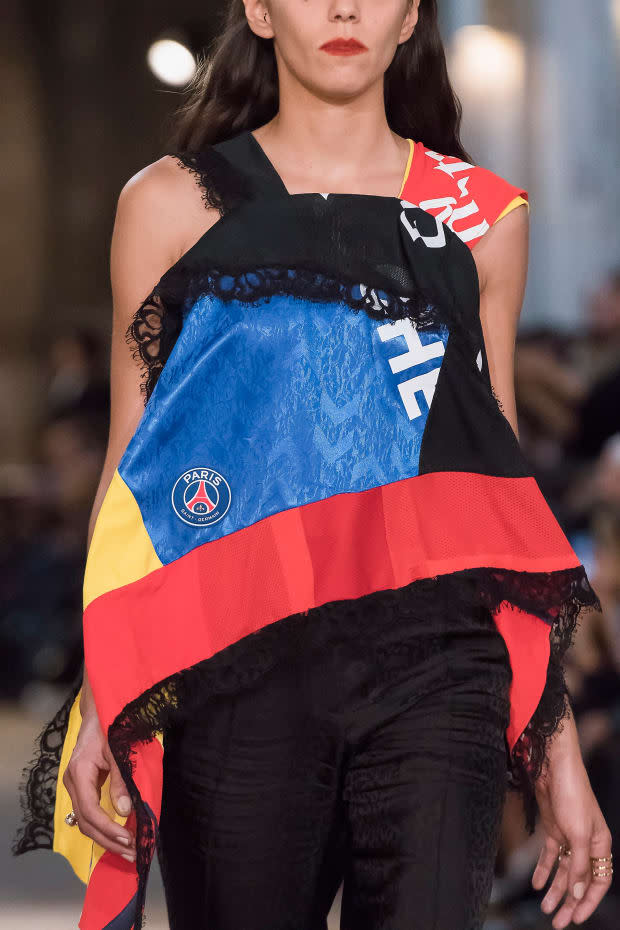How Christelle Kocher is Building a Modern French Fashion House
- Oops!Something went wrong.Please try again later.
- Oops!Something went wrong.Please try again later.
- Oops!Something went wrong.Please try again later.
The founder of Koché has also been the artistic director of Maison Lemarié for more than a decade, hand-picked by Virginie Viard to work on Chanel's Métiers D'art.
In our long-running series "How I'm Making It," we talk to people making a living in the fashion and beauty industries about how they broke in and found success.
Christelle Kocher — the founder of the beloved sportswear-inspired, technique-driven ready-to-wear label Koché — is building a new kind of French heritage brand.
Since it launched in 2014, Koché has grown tremendously, been worn by celebrities (Beyoncé!!!) and gained major industry recognition. (It's been shortlisted for the LVMH Prize and took home the 2019 ANDAM Prize.) By many outside observers' metrics, it's been incredibly successful. Where it's arguably been the most impactful, though, is in not following a schema for what a luxury house looks like.
Koché is rooted in a desire to open up the experience of fashion — which manifests in the brand staging runway shows on the streets of Paris (literally, in the case of its fashion week debut for Spring 2015, outside the busy Chatêlet-Les Halles transit hub in the center of the city), connecting and collaborating with brands in other industries (such as Paris Saint Germain and AC Milan) and marrying traditions of haute couture craftsmanship with approachable daywear. That stems from how Kocher herself got into the business: She grew up working class in Strasbourg, and moved by herself to the U.K. after high school, apprenticing under Charles James' former assistant and then enrolling at Central Saint Martins.
"At the beginning, I was more fascinated by the making. For me, that was very magical," she says. "And of course, to tell story, to bring emotion to people, to bring a message, because that's what's really important — but also, to do it well, in a proper way. Because it's connected. It's part of culture. It's part of our heritage, of our history and I think that's so fascinating."
After graduating, Kocher worked at a laundry list of the world's most prestigious brands: Chloé, Sonia Rykiel, Dries Van Noten, Bottega Veneta. She eventually crossed paths with Virginie Viard, then Karl Lagerfeld's right hand at Chanel, who brought her on as artistic director of Maison Lemarié, one of the brand's Maisons D'art, in 2010, while she was still working at Bottega. (She remains with the company.)
View the original article to see embedded media.
With her many roles and projects, Kocher's ultimate goal, she says, is "to inspire people — students, young designers. I would just want to say to keep believing in your dream, and keep dreaming big."
Ahead, read all about Kocher's career, from the origins of her love of fashion to her biggest influences to how she weighs the opportunities that come across her desk (which are many nowadays).
Where did your interest in fashion come from?
I was very interested in the manual [aspect of fashion]. My grandma and mother were knitters, and my grandmother knew about lace-making and crochet.
From a young age, I loved to draw, spend time by myself and be creative. I grew up in France, and France, of course, is a fashion country. You always had some TV show, pictures from a fashion show... I remember every fashion week, [there would be] a report about Christian Lacroix, Chanel or Jean-Paul Gaultier. That made me dream.
I grew up in the east, with a non-fashion background — my mom and dad stopped school at 14, and I have no connection to fashion at all. I was lucky to have teachers and my sports coach motivate me to pursue my dream. When I started, a teacher was like, '[It] will be very difficult because you have no connection.' I think a lot of people give up because it's just so difficult when you don't have the cultural background. At the beginning, to be honest, I was very embarrassed of my origin; now, I'm very proud. What I do in fashion, I think, is a great tool... [to] make [people] dream... Your dream is possible — in France, yes, it's hard, but it's possible. I'm the proof that it's possible.
When did you decide that you wanted to pursue it as a career?
I'm very stubborn. I remember maybe being eight, nine years old, like, 'Oh, I'm going to be a fashion designer.' My father would reply: 'And me, I want to be the president of France.'
I was very good student, and I worked very hard. I loved to read. I loved math. I did my A-level in mathematics. My teacher was very scared, because I was the best in my class; she [would say,] 'You're going to ruin your career. You can be a doctor or an engineer.' I was also doing sports, playing in the French championships, training every day, with a match every weekend. But on top of that, I was still going to my evening drawing class, and on weekends, I would illustrate and stitch clothes.
Since I was 14, I was also working — babysitting, washing dishes at restaurants, whatever. I saved money and at 17, when I graduated, I left my home to do whatever I wanted. My parents, at the beginning, didn't support it at all. They supported it later, but at the beginning, they were very shocked.
I wanted to learn the old-school way of pattern-cutting and draping. I got a scholarship to go to England [and study with] a teacher who was the last assistant for Charles James. It was very intense, but he was so interesting. He was a big fan of construction — of Cristóbal Balenciaga, John Galliano, Rei Kawakubo, Madeleine Vionnet, Madame Grès.
[He taught me] to study tailoring, to drape and be very fluid... For me, it was really about the craft of making clothes. He had a membership to the Victoria and Albert Museum, and he would take me there and show me the inside of a Madeleine Vionnet dress. Maybe that's what I like so much about pattern-cutting, and why I still drape and cut myself today — it's something quite mathematical. It's very rigorous; you have a certain technique for cutting a sleeve, for diamond gusset, for a dropping shoulder. At the same time, when you drape, it's like a sculpture. It's very poetic. It's about the fabric talking to you. It's about the sensuality of the fabric. It's a combination of art and technique.
Was your goal when you moved to England to enroll at Central Saint Martins?
I learned about the school in the library, when I was 15 years old, in some French magazine. My first choice, to be honest, wasn't Central Saint Martins — my dream was Bunka. I wanted to go to Japan. But I couldn't find a way to get money to go to Japan. My heroes were Rei Kawabuko, Yohji Yamamoto, Issey Miyake, Kenzo Takada... I have a big fascination for Japan, the pattern-cutting, the construction; the way they approach the garments, for me, was very artistic and very interesting. And of course, Alexander McQueen, John Galliano, for sure.
For me, also, [I identified with] where McQueen comes from. His father was a taxi driver. He went to London and was booming with the art and music in the '90s. [After that,] London and Central Saint Martins became a goal. I wanted to go, but I needed to find a scholarship. I had a full-time job on top of my study in England.
What were the biggest lessons you learned at Central Saint Martins that stick with you today?
At Central Saint Martins, they encourage you to be unique, to think for yourself, to bring a very personal message and to develop your own identity. There were certain things that became a trademark at Koché: to work in Central Saint Martins at the time, in the middle of Soho, with students very passionate about what they were doing, from all around the world — Japanese, Brazilian, American, Dutch, German, Chinese — and everybody telling this different point of view, working like crazy... For me, it was very inspiring to see every time you got a brief, how you would develop it and do it differently with your own culture, own taste, own identity.
How did your first job after fashion school set you on your career path?
When I graduated, I got a job at Armani. It was so interesting to see how a big fashion firm operated on a larger scale, in a very international level, where they have their own factory and their own different lines. It's just really — in a good way, too — industrial. That was very different, for sure, from Central Saint Martins. For me, it was also really interesting how they managed it online, with Emporio Armani, Armani, the more couture line. It was this very big, big, big company, very corporate... I still remember it very well, and it still inspires me, the way [Mr. Armani] became a legend and built this empire.
You worked for a bunch of different brands after that — Chloé, Sonia Rykiel, Dries Van Noten. Then, in 2010, you were hired by Karl Lagerfeld and Virginie Viard to be artistic director of Maison Lemarié, the craft atelier that makes the feather and flower embellishments for Chanel. What made you interested in taking on that role?
It was very surprising. I met Virginie when I was working at Chloé, and she knew that I was very passionate about craft and that I love technique. Virginie, she started like that, in embroidery, with Karl. We really connected, and we stayed in touch. She proposed me for this project, and I was like, 'Oh, really?' It was a dream to work on couture with an atelier.
In 2010, I did Lemarié and, at the same time, I was a senior designer at Bottega Veneta, [working] with Tomas Maier on ready-to-wear. I didn't want to give up on the fashion, and I didn't need to. [Virginie] gave me a white card, and she really believed that I could develop and do something, because I have an understanding [of fashion] and I have also this international experience that she appreciates. I have this passion, but in a modern way. I learned the old technique and craftsmanship, so I could sit there with them [in the atelier], cutting bias... They really respect me.
But I really wanted to bring modernity, to take the history and the technique from the past and bring this tradition into the future. I'm really keen to pass on the craft to whoever comes later, to get all generations interested, so it doesn't disappear. We're doing things in a modern, ethical way that inspires, that's good to wear and that still makes you dream. We innovate thanks to new technology and industry development; we can do things that we couldn't 15, 100 years ago.
At the beginning, they gave me a little team of about 10, 12 people. Today, we're about 130. We grew up. Karl loved the craft — Virginie, too. The ability to work with them since then, it's incredible.
What does the day-to-day job of an artistic director for a craft atelier look like? How has that changed in the decade-plus you've worked at Maison Lemarié?
We had a very small, family-owned atelier in the center of Paris. It was this house where the founder, the mother and the grandmother worked. It was very charming, but not very practical. Now, we're very lucky. We're moving to a big building that Chanel constructed at the boundary of Paris. We could do small things, like one-of-a-kind, exceptional [pieces] for haute couture that take hours and hours, but now, we can really do production. We're not industrial, but we can do a few thousand bows or camellias every year, in-house, in Paris.
With the team, we try to surprise ourselves. We can start with a technique, we can start with a contemporary art painting as inspiration. Sometimes it can be about the weaving of a chair — 'Oh, can we apply that in what we do, through 3D printing or laser cuts?'
It's teamwork. I'm like the orchestra chief: I have the vision; Virginie has the bigger vision, people have the technique. It takes so many hours for some pieces. Nothing you do is by yourself — sometimes, 50 people can work on one piece. That synergy, when you see finished, wow, it's great.

Photo: Andreas Rentz/Getty Images
How do you split your time across two different roles, first when you were working at Bottega Veneta and now with Koché?
It's become quite natural to me, after many years of working this way and observing different people, like Karl Lagerfeld, who was a multi-tasker and had many jobs. I [don't have] the same schedule every day. That doesn't work for me. I work a lot [from a] distance, but I'm always connected with my phone. I'm in contact [with people] every day, on Whats App.
Did you always know you wanted to start your own brand?
It was always a dream for me. I wanted to be independent to start — it doesn't mean that I will stay forever, but I wanted to bring my own vision, and that felt very important.
I felt like it was a good timing, after working so many years: I understood the business side, the creativity. I felt confident because I had a 360-degree view on fashion, on having an international brand, on managing a team, on funding.
The idea was to bring the technique of couture and mix it with streetwear, sportswear and more casual wear, [to create] a brand that speaks to everyone, that brings openness and inclusivity, that's very welcoming for every kind of person, tradition, gender, culture. I wanted to open the fashion world to different people, and also to bring the craft to everyone. That's why today, even in my brand, I work with Lemarié; the collection is produced in Italy, and the more couture pieces are produced in Paris.

Photo: Imaxtree
What have been the biggest moments for Koché since you started the brand in 2014?
The biggest is yet to come, I guess, because I want to get better. But my first show was a big moment, because it was very meaningful, to do it on the street, outside the tube station in the center of Paris. It was very welcoming to everyone. Editors were there, buyers, some students, some curious people — it was very spontaneous and very beautiful. I had a street casting mixed with top models.
After that, working with Paris Saint-Germain on a soccer collection, I liked because I did 12 years of sport. Football, for me, is this really popular culture — the biggest sport in Europe. It talks to every generation, every social class. It brings inclusivity, opportunity, celebration. The sport [has] a lot of very beautiful things, and I wanted to bring that [in] with fashion. And with a club like Paris Saint-Germain, which is emblematic in Paris, that was very big.
I have many surprises for Koché, and a good one coming for September — and even bigger ones, I'm sure, to come in the future.

Photo: Imaxtree
When you get a new opportunity for Koché or for yourself — like how you recently designed for Charles Jourdan — how do you decide if it's the right fit?
I was the artistic director of Charles Jourdan for just two seasons. For me, the interest was that he was a legend in shoemaking, and you get back into the story of the craft. It was about bringing back and setting up the brand for a new chapter, and that was very stimulating, to reappropriate the history and the heritage of this house. It always needs to make sense, for Koché and for me, and it needs to connect.
What's the best piece of advice you've ever received?
Keep being curious and keep working hard. Karl was always very, very curious. After each collection, he would [say,] 'Okay, what's next?' He was always on to the next, because there must be another opportunity — to do a new collection, to do something else, to do something new.
Also, when you're an entrepreneur, to be very considerate about your cash flow. Always watch your finances. It's so important, especially after everything that's happened.
This interview has been edited and condensed for clarity.
Never miss the latest fashion industry news. Sign up for the Fashionista daily newsletter.
